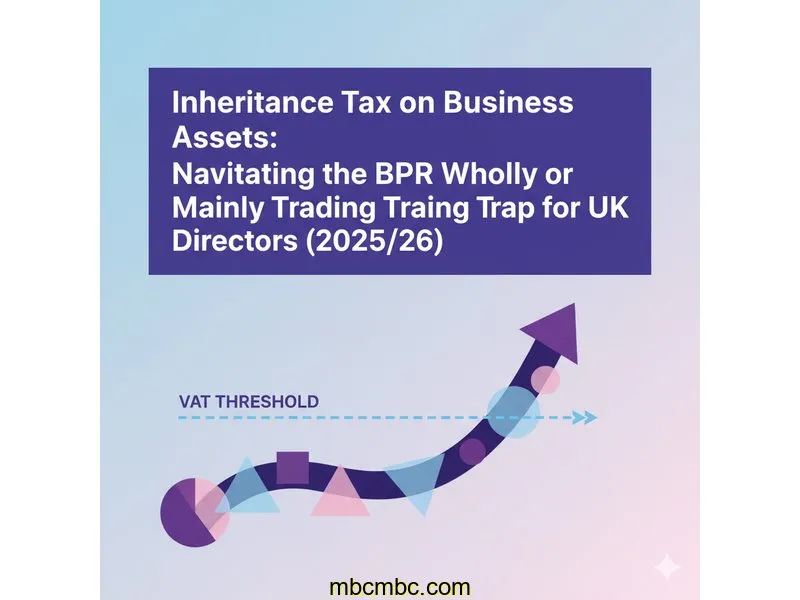
Picture this: You’re a director of a successful UK-based tech company. You’ve worked for decades, built the business up, and you assume your shares are safe from Inheritance Tax (IHT). Why? Because of **Business Property Relief (BPR)**. But here’s the problem: when it comes to IHT, assumptions are a dangerous game. Your company might be doing great work, but if a substantial part of its value comes from passive activities—like holding a large portfolio of commercial property or a massive cash pile in the bank—those shares might not qualify for BPR at all. This is the **'wholly or mainly trading' trap** that catches out countless business owners in the UK.
This ambiguity isn't just confusing; it can be catastrophically expensive. IHT is currently levied at 40% above the available nil-rate bands, meaning a business worth £5 million could face an unexpected £2 million IHT bill upon the owner's death simply because HMRC decided the company wasn't 'wholly or mainly trading.' As Alex Williams, founder and lead researcher for FinTools UK, I’ve seen how often the core test of BPR is misunderstood. Let's explore the HMRC criteria for BPR and how to structure your business to give its shares the best chance of qualifying for 100% IHT relief.
Key Takeaways
- Core Rule 1: To qualify for 100% BPR, a company must be ‘wholly or mainly’ engaged in trading activity, not holding investments. This is HMRC’s primary test.
- Core Rule 2: The 'mainly' threshold is generally interpreted by case law as at least **51%** of a company's activities needing to be trading, based on a holistic assessment.
- Key Data Point: The use of BPR is rapidly increasing; in 2021/22, a total of **£2.1 billion** was relieved from IHT using BPR, a 30% increase from the previous year (HMRC Statistics, 2023).
- When to Act: If your company's passive assets (like investment properties or large cash reserves) exceed **49%** of its overall value or activity, you should seek a review immediately.
- Disclaimer: This article provides informational guidance based on HMRC rules as of 2025. It is not financial or legal advice. IHT planning is highly specific and subject to complex case law—always consult a qualified tax or estate planning professional for your specific situation.
Understanding the BPR 'Wholly or Mainly Trading' Test 🧐
The entire concept of BPR is designed to protect genuine businesses and encourage investment, not to simply shelter wealth held in investments. The relief grants either 50% or 100% IHT relief on 'relevant business property,' which includes shares in an unlisted company or a controlling shareholding in a listed company.
But here’s the fundamental question HMRC asks: **Is the business carrying on a business of making or holding investments?** If the answer is yes, then BPR is completely denied. If the answer is no, it’s still denied if the business is **'wholly or mainly'** one of holding investments. It's a subtle but critical distinction.
Think of the 'wholly or mainly trading' test like a **see-saw**. On one side you have 'Trading Activity' (sales, manufacturing, design, service delivery), and on the other, you have 'Investment Activity' (collecting rent, earning bank interest, passive share dealing). For BPR to apply, the trading side must clearly outweigh the investment side. The term 'mainly' is generally interpreted by case law as **more than 50%**, meaning you must demonstrate that at least 51% of the business's activity is focused on trading.
HMRC doesn't just look at one metric; they take a holistic approach, weighing up five key factors to determine the true nature of the business (HMRC IHTM25263):
- Activity: How do employees spend their time? (The most crucial factor)
- Income: How much of the revenue is generated by trading vs. investments?
- Capital Employed: What is the ratio of trading assets to investment assets?
- Historical Perspective: Has the nature of the business changed over time?
- The Company's Own Statement: What does the company documentation (e.g., Memorandum & Articles) say about its purpose?
This matters profoundly because, according to a recent analysis of IHT claims, BPR claims made by company directors face significantly higher scrutiny if the business holds **more than 40%** of its assets in passive forms (Institute of Financial Planning Research, 2024). This indicates that while the legal threshold is 51%, the practical risk zone starts much lower.
The Excluded Assets & The Cash Trap 💰
The biggest threat to BPR is what HMRC calls **'Excepted Assets'**. These are assets that are not used wholly or mainly for the purposes of the business in the period leading up to the transfer (usually the two years before death). The two most common culprits for directors are:
- Investment Property: Owning the factory is trading; owning a separate portfolio of buy-to-let flats is investment.
- **Excess Cash:** This is the most common trap. If the company has a massive cash reserve that is not demonstrably required for future trading activities (e.g., funding an R&D project, buying new machinery), HMRC can deem that cash an 'Excepted Asset' and deny BPR on that portion of the business’s value.
Think of the cash trap like a **financial spare tyre**. It’s fine to have a spare that covers a flat (working capital), but if you’re carrying five spares just because you can (excess reserves), HMRC views those extras as a passive investment, not a trading necessity. The burden of proof is always on the business owner's estate to justify why the cash is needed for the business.
Scenario-Based Breakdown: Does My Business Qualify for BPR?
To make sense of the 'wholly or mainly trading' test, let's break down three common business scenarios. The table below illustrates how a seemingly small difference in activity can lead to a 40% tax difference on death.
| Customer Scenario | Trading Activity | Investment Activity | BPR Outcome | Reasoning |
|---|---|---|---|---|
| Tech Start-up (Scenario A) | Software design, R&D, sales (90%) | £100k cash for 6 months payroll (10%) | 100% BPR Likely | Trading is clearly the main activity. Cash reserve is necessary working capital. |
| Property Developer (Scenario B) | Buying, renovating, selling homes (60%) | Holding 3 rental properties for 5+ years (40%) | 50-100% BPR High Risk | The 40% passive holding puts it too close to the 51% threshold. HMRC may argue the 'holding' is an investment business. |
| Consultancy with Cash (Scenario C) | Live client consultancy, service delivery (55%) | £2.5m cash on deposit, used for 5 years (45%) | Partial BPR Denied | While income/time is 55% trading, the massive **Capital Employed** on the passive side (the cash) is an Excepted Asset and likely drags the whole enterprise under the 'wholly or mainly trading' test. |
As you can see, the outcome is rarely black and white. For the Property Developer, the key would be proving that the rental properties are temporary holdings awaiting sale, not long-term investments. For the Consultancy, the £2.5m cash reserve is a major red flag—unless they can prove it's earmarked for an imminent, specific business need, it’s going to fail the BPR test.
Mitigating the Risk: Practical Steps for Directors

If you've reviewed your balance sheet and suspect you’re approaching the BPR risk zone, there are proactive steps you can take. The key is to manage the ratio of trading assets to excepted assets and clearly document the use of all funds.
Step-by-Step: Managing Excepted Assets
1. Audit Your Balance Sheet: Categorise every asset (cash, property, shares) as either 'Trading Purpose' or 'Excepted/Investment'. Be honest—if the cash hasn't moved in five years, it's an investment.
2. Document 'Necessary' Cash: If you hold large cash reserves, create a formal **Board Resolution** or management document explaining exactly what the cash is for (e.g., "Future purchase of new Bristol office premises Q4 2026," "Contingency for known lawsuit/bad debt"). This demonstrates the funds are not passive.
3. Extract and Invest Privately: If the cash or investment property truly serves no business purpose, the director can take it out of the company via salary/dividends (paying Income Tax/Dividend Tax) or by purchasing it personally. This leaves a 'cleaner' trading company eligible for BPR and transfers the excepted assets to the individual's estate, where other IHT reliefs (like the Residence Nil-Rate Band or gifting rules) might apply.
4. Re-Invest in Trading Assets: Use excess cash to fund genuine business growth, such as hiring staff, increasing inventory, or expanding manufacturing capability. This immediately shifts the balance towards trading activity.
Common Questions About the BPR Trap
Based on questions I’ve seen across UK business forums and discussions with accountants, here are the three most common points of confusion.
Does holding the company’s premises via a SIPP affect BPR?
No, this is one of the safest strategies. If the director’s SIPP (Self-Invested Personal Pension) owns the commercial property and the company pays rent to the SIPP, the property is a personal pension asset, which is completely outside the scope of IHT. The trading company remains 'clean' and qualifies for BPR, while the SIPP, which is already an IHT-exempt wrapper, holds the valuable property. This is a highly effective, but complex, two-part strategy.
If my company holds one large buy-to-let property, is BPR automatically denied?
Not automatically, but it is extremely high risk. A single buy-to-let business is almost always classified as one of holding investments, which fails the BPR test entirely. For a company that combines trading (e.g., manufacturing) with investment (the rental property), you must ensure the trading element is 'wholly or mainly' dominant. If the property's value exceeds 49% of the total company value, or if employee time spent on the property is significant, the BPR claim will likely be rejected.
Is there a specific percentage of cash that HMRC allows?
No, HMRC does not publish a percentage figure, which is frustratingly vague. The question is always one of **necessity**. If a company turns over £10 million but needs £500k for stock and cash flow, a £2 million reserve is likely deemed an excepted asset. Conversely, if a manufacturing firm needs £5 million to purchase a new plant in 18 months, that is necessary cash. The rule of thumb is often set by the business's working capital cycle—how much cash is needed to keep the lights on for 6-12 months? Anything significantly over that needs robust documentation.
Conclusion: Your Next Steps
The 'wholly or mainly trading' test is the single biggest point of failure for Business Property Relief claims on private UK company shares. It's a qualitative test, not just a mathematical one, relying on a balanced assessment of activity, income, and capital employed. If your business has any material passive assets, the time to address this is now, not when a loved one is dealing with your estate.
If you're a UK company director, your first step should be to audit your balance sheet and activity profile to confirm your business is demonstrably 'mainly trading.' Look specifically at non-business assets and any substantial cash reserves, and create clear, dated board resolutions to justify their purpose. BPR is one of the most powerful IHT reliefs available, but its rules are intricate and the consequences of misinterpretation are severe—this guide provides a necessary framework, but for a conclusive assessment and structuring strategy, always consult a qualified IHT specialist or tax adviser. They can help you navigate the fine line between necessary reserve and a costly excepted asset.

